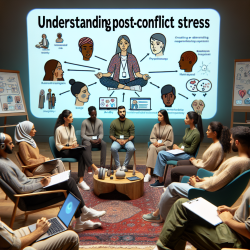Understanding Post-Conflict Stress: Insights for Practitioners
In the aftermath of the January 2022 unrest in Kazakhstan, a comprehensive national survey was conducted to evaluate the acute stress reactions experienced by the population. This study, published in Heliyon, provides valuable insights into the prevalence of post-traumatic stress disorder (PTSD) and generalized anxiety disorder (GAD) among those affected by the civil disturbances. As practitioners dedicated to improving mental health outcomes, understanding these findings can guide our interventions and encourage further research.
Key Findings from the Study
The survey, which included 6,510 participants, revealed significant emotional distress among the population, particularly in regions most affected by the unrest. Key findings include:
- High Prevalence of PTSD: In Almaty city and region, 30% of participants exhibited symptoms of PTSD with a cut-off score of ≥3 on the PC-PTSD-5 scale, compared to a national prevalence of 14.8%.
- Anxiety Symptoms: The prevalence of anxiety symptoms, as measured by the GAD-7 scale, was notably higher in Almaty, with 28.2% of residents affected, compared to 10.9% nationally.
- Demographic Variations: The study found that older age, female gender, and being divorced were associated with higher rates of stress and anxiety symptoms.
Implications for Practitioners
These findings underscore the need for targeted mental health interventions in regions affected by civil unrest. Practitioners can enhance their skills and improve outcomes by considering the following strategies:
- Implement Targeted Interventions: Focus on providing mental health support in regions with the highest prevalence of stress symptoms, such as Almaty.
- Utilize Screening Tools: Incorporate validated screening tools like the PC-PTSD-5 and GAD-7 in practice to identify individuals at risk and tailor interventions accordingly.
- Promote Community Support: Encourage community-based programs that foster social cohesion and provide a support network for individuals experiencing emotional distress.
- Focus on Vulnerable Populations: Pay special attention to demographic groups identified as more vulnerable, including older adults, women, and those with disrupted family structures.
Encouraging Further Research
While this study provides critical insights, it also highlights the need for ongoing research to better understand the long-term mental health impacts of civil unrest. Practitioners are encouraged to engage in or support research efforts that explore:
- The effectiveness of different intervention strategies in reducing PTSD and anxiety symptoms.
- The role of media exposure and community spillover effects on mental health during and after unrest.
- The impact of socio-economic factors on the mental health outcomes of affected populations.
By staying informed and actively participating in research, practitioners can contribute to the development of evidence-based interventions that address the unique needs of populations affected by conflict.
To read the original research paper, please follow this link: Post-conflict acute stress reactions in Kazakhstan in the aftermath of January 2022 unrests: A national survey.










